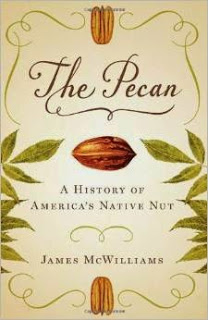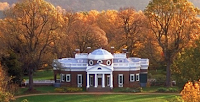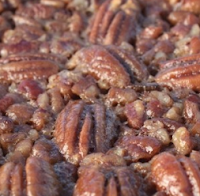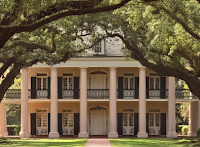
What’s a Texas pecan pie for dieters? It’s the same as the normal pie– loads of pecans, butter, and sugar– but it’s a tiny pie. And I happen to have the perfect tiny Texas pie dish for it– a work of art by Alpine, Texas-based ceramic artist Judy Howell Freeman. It’s one of the loveliest pie dishes I have ever seen. My photo does not do it justice.

C.M. MAYO’S TEXAS PECAN PIE FOR DIETERS
(For a standard-sized pie, double this recipe)
Butter Crust:
1 1/4 cup flour
1 tablespoon sugar
dash of salt
1/2 cup butter cut into itty bits
3 tablespoons ice water
>>Mix it all up! Squoosh it and roll it until it forms a ball; then roll it flat (like a thick little frisbee); then wrap it in plastic or pastry paper and park it in the fridge for at least an hour.
Pie Filling:
2 eggs, beaten
1/4 cup sugar
pat of butter (about what you would use to generously butter a roll)
1/2 cup honey (raw– otherwise don’t bother, just get the corn syrup)
1/2 teaspoon each of cinnamon, cardamom, cloves, ginger
1/4 teaspoon ground black pepper (YES DO IT!)
dash of salt
a couple of handfuls of pecans
>>Mix it all up, except for the pecans
>>Roll out the dough and fit to a greased tiny pie pan. Do not leave extra crust around the rim; this is a diet pie!
>>Fill ‘er up. Drop the pecans on top. Arrange pecan pieces artistically if you feel so moved.
>>Bake pie @ 350 F = (approximately 175 C) for about 45 minutes
>>Then cover the pie pan with a lid or foil, and continue baking until a toothpick comes out clean of the pie’s center (takes probably another 30 to 45 minutes).
>>Remove from oven and let it set for about 45 minutes.
>>To slice, use an extra sharp knife.
(If you do not allow it to cool and if you use a dull knife it will end up on the plate looking like a slobby cobbler.)

#
Back in January of this year (2019) I started migrating selected posts from the old blogger platform to this page, www.madam-mayo.com, which is self-hosted WordPress. So far, so swimmingly, as I continue work on the Far West Texas book and related Marfa Mondays Podcasting Project. You can now find not all but a generous number of the Texas posts here, among them, this review of James McWilliams’ The Pecan.

BOOK REVIEW by C.M. Mayo
Originally published on Madam Mayo blog, July 5, 2015
The Pecan: A History of America’s Native Nut
by James McWilliams
The University of Texas Press, 2013
ISBN 978-0-292-74916-0
Hardcover pp. 192
Crisply entertaining and chock-full of crunchy research by a food historian, this apparently delicious little book on America’s native nut— (and isn’t the cover charming?)— is a horror story.
It opens, as the darkest do, with a sunny scene of innocence. Clustered along river bottoms in what would one day become Texas, groves of pecan trees rained down their bounty for wildlife and indigenous peoples. For centuries, pecans were their superfood, dense with calories and nutrition. In the 16th century, Alvar Nuñez Cabeza de Vaca, the conquistador who shipwrecked en route to Florida and wandered west, found the Guadalupe River “a river of nuts”— although he had no word for them but “walnut.” The name “pecan” dates from the late 18th century.

The pecan did not do well further north. Thomas Jefferson planted some 200 pecan trees in Monticello; none survive. Where nuts were wanted, European walnut varieties proved more popular and versatile, so the pecan was left to do what it had always done, thrive in its wild state along river bottoms, mainly in what is today Texas. Notes McWilliams, “unlike any other fruit-bearing tree in the age of cultivation, the pecan managed to evade the cultivating hand of man for centuries after humans began exploiting it for food.”

In the nineteenth century, as ranching and cash crops such as cotton, corn and wheat spread across the South and Midwest, many pecan trees disappeared; nonetheless, a large number of pecan groves survived, especially in Texas, because they clung to riverbanks and bottoms, and proved able to survive a flood other crops could not.
Farmers found wild pecans not only delicious as snacks for themselves, but good pig feed, and bags of them, easily gathered, could be sold in new markets in San Antonio, Galveston, and New Orleans. In the second half of the 19th century, Texas took the lead in pecan production, but not from formal orchards; for the most part, farmers gathered wild pecans.
How to sell more pecans? The market wanted uniformity, thin shells, and dense nut meats. Even the most magnificent pecan tree’s seed, however, would not “come true,” that is, bring forth a tree producing equivalent quality nuts. The solution was grafting. As early as 1822 one Abner Landrum detailed his own successful experiments with pecan grafting in the American Farmer. It seems no farmer bothered to emulate that experiment. The market for pecans was still marginal and, as McWilliams ventures, “it was simply more macho to run a ranch with cattle than to turn that land over to pecans.”

In the mid-century 19th century, in the Oak Alley Plantation in Louisiana, a slave gardener named Antoine successfully grafted an orchard of more than 100 fabulously productive pecan trees. Decades later, the plantation’s new German owner, Herbert Bonzano, brought the nuts of those grafted pecans to Philadelphia’s 1876 Centennial Exposition. And thus, like so many other fruits before it, the pecan was at last, if slowly, on the road to industrial production— a road, like that to Hell, paved with good intentions.
the pecan was at last, if slowly, on the road to industrial production— a road, like that to Hell, paved with good intentions.
For a time, farmers relied on wild pecans, resisting experts’ advice to graft pecans, perhaps out of innate conservatism and a reluctance to becoming dependent on nurserymen. Attitudes soon changed. After a series of insect plagues in the last three decades of the 19th century decimated major cash crops, the USDA championed chemical insecticides that, “lo and behold, worked.” Writes McWilliams, “The USDA was no oracle, but as pecan farmers recognized, history showed it could make life much easier for those who tilled the soil for a living. So long as they would listen.” Listen they did.
The 20th century brought increasing industrialization in pecan production. After World War I, writes McWilliams, “pecan trees were becoming carefully managed commodities rather than natural aspects of the southern landscape.” As for shelling, an important source of employment in San Antonio in the 30s, after some labor unrest, this was given over to machines.
In World War II the U.S. government gave the pecan industry a push, promoting the nuts as nutritious replacements for meat; and after imposing price ceilings to help promote consumer demand, buying up millions of pounds of surplus pecans (many fed to schoolchildren). By the late 1940s, pecans were no longer holiday treats or just for pralines, they were in everything from cakes to cookies to pies, even salads. McWilliams: “The aristocrat of nuts had become a commoner.”
McWilliams brings the pecan through the rest of its 20th century
history with mail order, frozen foods, processed foods, chain
restaurants, granola, and ice cream; its oil extracted for lubricants in
clocks and guns, its wood milled for basketball court flooring, its
shells collected for mulch, barbecue chips, plywood, pesticides, and
more. By 2011, when the author tours a Texan pecan farm, he is stuck
with dark wonder:
“First, the entire operation is a streamlined model of mechanization. Vehicles designed to fit snugly between seemingly endless rows of perfectly aligned pecan trees spray pesticides, herbicides, and fungicides; they lay mulch, prune trees, apply fertilizer, and harvest nuts. Other machines disk the soil and smooth the turf between the trees so that fallen nuts do not elude harvest. At times helicopters are even brought in for the purpose of keeping frost from icing the nuts. Propane cannons are on hand to scare off crows. It occurred to me as we drove from orchard to orchard that there was nothing ‘natural’ about a contemporary pecan orchard.I was looking at a factory in the field.”
Oh, but it gets stranger. The money isn’t so much in the pecans as it is in shipping trees from the nursery to China. In 2001, Chinese did not have a word for pecan. Today pecans are a popular health food in China, available everywhere from airports to gas stations. It seems a question of time before the Chinese outstrip the U.S. in pecan production.
The future of the pecan, a “chemically saturated activity,” whether in the U.S. or China or elsewhere, looks grim. Arsenals of insecticides are increasingly necessary to combat aphids, beetles, weevils and more. These chemicals also threaten bees and other pollinators (and without them, our food supply as we know it may collapse). Plant diseases are also becoming increasingly resistant to chemical assault. The soil degrades. At some point— perhaps when China has become the top producer; perhaps when some insect or fungus has wiped out enough orchards; or in the wake of some ecological or economic jolt— it may become unprofitable to continue producing pecans in the U.S., the grafted and chemically attended ones for the mass market, that is.
What then will have become of the now few stands of wild pecans? The good intentions of many decades—ye olde single-minded “economic development”— have brought this once thriving wild nut tree to a state of such fragility that, concludes McWilliams, “we may well lose yet another natural thread to the past.”
# # # # #
>Your comments are always welcome. Click here to send me an email.

Lone Star Nation: How Texas Will Transform America by Richard Parker
Marfa Mondays Podcasting Project:
Cynthia McAllister with the Buzz on the Bees
A Visit to El Paso’s “The Equestrian”
Visit my website for more about my books, articles, and podcasts.



